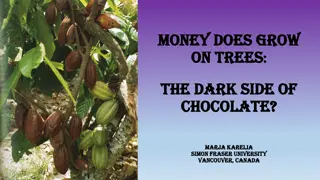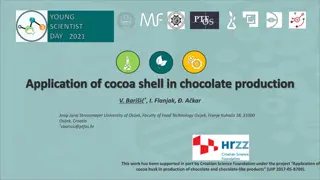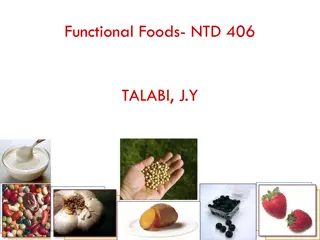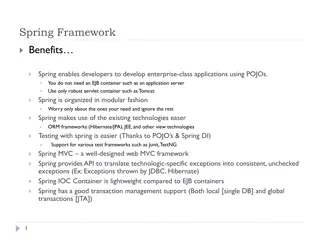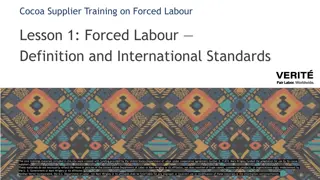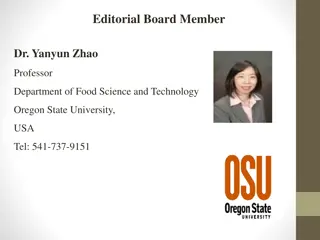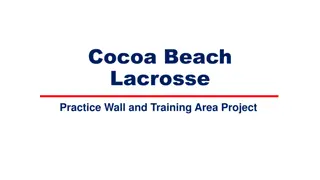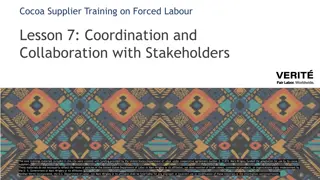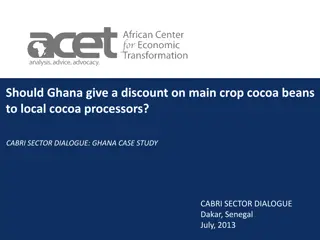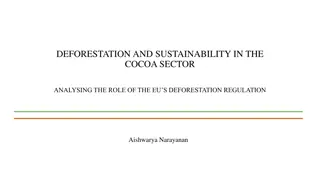Cocoa Bean Processing in Food Technology Course
The Cocoa Bean Processing Department offers a Dairy Technology course focused on Food Technology. Cocoa beans, also known as cacao beans, are the basis of chocolate and various Mesoamerican foods. There are different cocoa varieties such as Criollo, Forastero, and Trinitario, each with distinct characteristics. Cocoa trees were originally exclusive to the Americas but are now cultivated worldwide. The processing of cocoa beans involves fermentation, cleaning, drying, and grading to produce high-quality cocoa products.
Download Presentation

Please find below an Image/Link to download the presentation.
The content on the website is provided AS IS for your information and personal use only. It may not be sold, licensed, or shared on other websites without obtaining consent from the author.If you encounter any issues during the download, it is possible that the publisher has removed the file from their server.
You are allowed to download the files provided on this website for personal or commercial use, subject to the condition that they are used lawfully. All files are the property of their respective owners.
The content on the website is provided AS IS for your information and personal use only. It may not be sold, licensed, or shared on other websites without obtaining consent from the author.
E N D
Presentation Transcript
COCOA BEAN PROCESSING DEPARTMENT : DAIRY TECHNOLOGY COURSE TITLE : FOOD TECHNOLOGY I COURSE NO. : DTT -322 COURSE TEACHER: BIPIN KUMAR SINGH
COCOA The Swedish botanist Linnaeus named cocoa bean Theobroma cacao, meaning food of the Gods to reflect its spiritual and social importance to the Mayans and Aztecs. The cacao tree is strictly tropical plant thriving only in hoy, humid climate. The cocoa bean or simply cocoa, which is also called the cacao bean or cacao, is the dried and fully fermented seed of Theobroma cacao, from which cocoa solids and cocoa butter can be extracted. Cocoa beans are the basis of chocolate, and Mesoamerican foods including tejate, an indigenous Mexican drink that also includes maize.
Varieties of Cocoa Criollo: It has white cotyledons. The chocolate made out of it is of light brown colour quite like milk chocolate. It has pleasant flavour, nutty type with only a mild typical chocolate flavour. Criollo is rare in production. Criollo (regarded as flavour cocoa) is mostly grown in Central and South America. Forastero: Most of the world s cocoa is derived from Forastero trees (i.e. 95% of world cocoa crop). It is made up of small, flattish and purple beans. Trinitario: It is a hybrid between Forastero and Criollo trees. It is a disease resistant hybrid, regarded as a flavour bean. It has a strong chocolate flavour; in addition ancillary flavours such as fruity, raisin, caramel, molasses and spicy notes. It is the most fully-flavoured cocoas. It is ~ 3% of world production. The Trinitario and Criollo varieties produce mainly the fine and flavour cocoas.
Contd Cocoa tree was exclusive to the Americas around the Valleys of Amazon and Orinoco rivers. West Africa produces over 70% of world cocoa. Now, cocoa trees are cultivated in more than 40 countries around the world. Certain cocoa trees become productive in 3-4 years, while in past 6-7 years was common. The pod contains some 40 seeds or beans. After fermentation and drying, one pod produces some 40 g of beans, 1 bean typically weighing around 1 g.
Cocoa Bean Processing Fermentation of beans Chemical changes: Anthocyanins and other polyphenolic compounds in the pigment cells can diffuse out into the adjacent main storage cells. The enzymes breakdown the coloured anthocyanins resulting in some bleaching of cotyledons. As more air reaches, oxidative or browning reactions start to predominate and the tissue darkens. Cleaning: The adhering pulp and mucous is removed. Cocoa beans, from silo storage or directly from their burlap bags, first pass through cleaning machines screens, magnets and controlled air streams. Extraneous materials removed include sticks, stones, string, and metal objects. .
Contd Drying: Sun Drying: It takes about a week of sunny weather to dry down to 7.0% moisture, needed to prevent mould growth during storage. Forced-air driers: Artificial drying poses two problems (a) Beans are dried too quickly resulting in beans becoming very acidic. (b) Smoke may find its way onto the beans, producing unpleasant acrid, smoky or tarry taste Cleaning and grading:From the silo storage/burlap bags, cocoa beans pass through cleaning machines: screens, magnets and controlled air streams. The extraneous material removed includes sticks, stones, string and metal objects
Contd Blending:Substantial variety in flavor exists among cocoa beans from different countries. It is seldom that one batch of beans will be used exclusively in a formula. One reason is that blending provides the opportunity to obtain a certain flavor. Another reason stems from the inconsistency of cocoa beans in flavor and other quality aspects. Batches of cocoa beans show variations from one locality to another, due to differences in the weather during growth and ripening, from differences in fermentation and other variations in processing conditions. Blending will contribute to uniformity. Thermal pre-treatment:An important quality aspect in cocoa bean processing is removal of the cocoa shell. The shell, as the covering of the kernel, is always greatly polluted with sand, high bacteria counts, and pesticide residues. Depending on the fermentation, the shell often sticks to the kernel, which prevents easy removal. Recently machines have been introduced which loosen the shells by means of a thermal shock. This is achieved with hot air, saturated steam, or infrared radiation.
Contd Breaking and Fanning (winnowing):To remove the shell, the beans are first broken between adjustable toothed subsequently separated in fractions by sieving. Each fraction is treated with a stream of air which carries away the light shell pieces. This breaking and fanning process is often referred to as winnowing. Roasting:The roasting process at 120 140 C is needed for the development of the typical flavor of cocoa. Using modern technology, cocoas can be roasted at different particle sizes, such as whole beans, or as liquid cocoa mass, which is produced by a fine grinding of cocoa and liquefying within its own fat. The roasting of smaller particles has the advantages of better controlled roasting, partial exhaustion of abundant acetic acid, and reduced roasting time (beans take about 30 min, nibs 12 min, mass 2 min). The type of roasting technique may also influence microbiological aspects. The bacteria present are on the shell and by removing the shell first the material enters the roasting (= sterilization) process with a lower initial bacteria count. rollers. The broken pieces are
Contd Grinding and refining:The next step is grinding of the cocoa nib particles. The nib consists of 55% cocoa butter and 45% solid material coming from the plant cells. The latter must be ground very finely. When eating chocolate or drinking chocolate milk, no grittiness should be felt in the mouth. For both cocoa powder and chocolate it is important that the final particle size distribution is narrow. This facilitates the pressing operation and improves the rheological properties of chocolate. The desired fineness (15 70 m) and particle size distribution are reached in several successive grinding steps. Pregrinding of the large and hard nib particles is done in disk mills, hammer mills, or pin mills. To reach the ultimate fineness, mass for pressing is refined in modern versions of the triple stone mill, or in vertical ball mills (attrittors). In the chocolate industry, roller mills with five rolls are most commonly used for refining the mass. These are also used to grind the chocolate mass, after adding preground sugar and milk powder.
Contd Packaging transported, it is usually packed into 30-kg cardboard boxes with a plastic liner or bag inside. In Europe and the USA most of the transport takes place in liquid form. and shelf-life:When cocoa mass has to be stored or Cocoa mass has a very good shelf-life. The solid particles are protected by a fat with a high degree of saturation. Moreover, cocoa contains powerful natural antioxidants. These conditions also apply to cocoa beans. If the moisture content of the beans is well under control, their shelf-life will be several years. (See ANTIOXIDANTS | Natural Antioxidants.)










